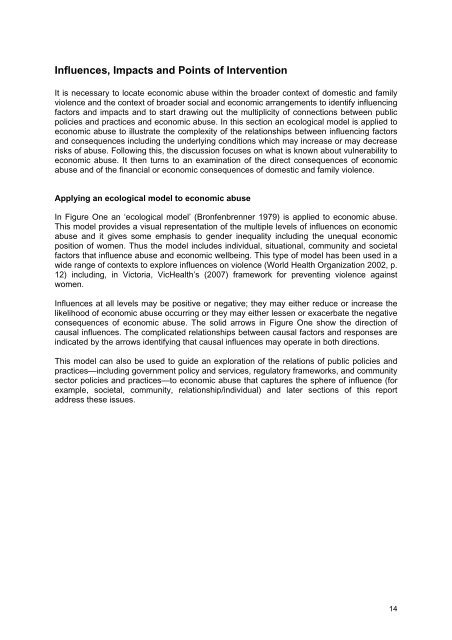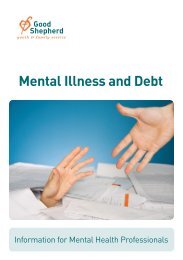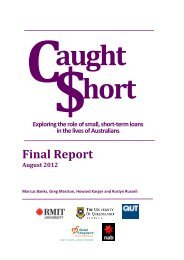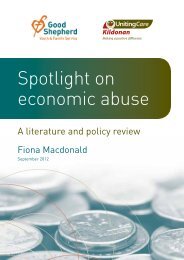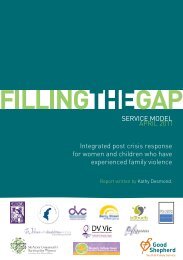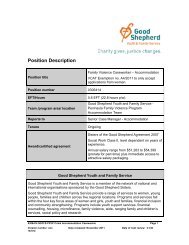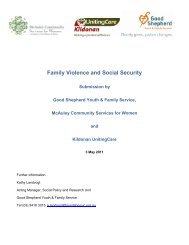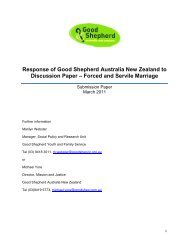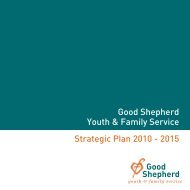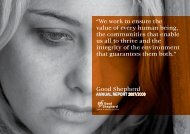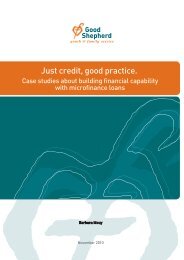Spotlight on economic abuse - Good Shepherd Youth & Family ...
Spotlight on economic abuse - Good Shepherd Youth & Family ...
Spotlight on economic abuse - Good Shepherd Youth & Family ...
You also want an ePaper? Increase the reach of your titles
YUMPU automatically turns print PDFs into web optimized ePapers that Google loves.
Influences, Impacts and Points of Interventi<strong>on</strong><br />
It is necessary to locate ec<strong>on</strong>omic <strong>abuse</strong> within the broader c<strong>on</strong>text of domestic and family<br />
violence and the c<strong>on</strong>text of broader social and ec<strong>on</strong>omic arrangements to identify influencing<br />
factors and impacts and to start drawing out the multiplicity of c<strong>on</strong>necti<strong>on</strong>s between public<br />
policies and practices and ec<strong>on</strong>omic <strong>abuse</strong>. In this secti<strong>on</strong> an ecological model is applied to<br />
ec<strong>on</strong>omic <strong>abuse</strong> to illustrate the complexity of the relati<strong>on</strong>ships between influencing factors<br />
and c<strong>on</strong>sequences including the underlying c<strong>on</strong>diti<strong>on</strong>s which may increase or may decrease<br />
risks of <strong>abuse</strong>. Following this, the discussi<strong>on</strong> focuses <strong>on</strong> what is known about vulnerability to<br />
ec<strong>on</strong>omic <strong>abuse</strong>. It then turns to an examinati<strong>on</strong> of the direct c<strong>on</strong>sequences of ec<strong>on</strong>omic<br />
<strong>abuse</strong> and of the financial or ec<strong>on</strong>omic c<strong>on</strong>sequences of domestic and family violence.<br />
Applying an ecological model to ec<strong>on</strong>omic <strong>abuse</strong><br />
In Figure One an ‘ecological model’ (Br<strong>on</strong>fenbrenner 1979) is applied to ec<strong>on</strong>omic <strong>abuse</strong>.<br />
This model provides a visual representati<strong>on</strong> of the multiple levels of influences <strong>on</strong> ec<strong>on</strong>omic<br />
<strong>abuse</strong> and it gives some emphasis to gender inequality including the unequal ec<strong>on</strong>omic<br />
positi<strong>on</strong> of women. Thus the model includes individual, situati<strong>on</strong>al, community and societal<br />
factors that influence <strong>abuse</strong> and ec<strong>on</strong>omic wellbeing. This type of model has been used in a<br />
wide range of c<strong>on</strong>texts to explore influences <strong>on</strong> violence (World Health Organizati<strong>on</strong> 2002, p.<br />
12) including, in Victoria, VicHealth’s (2007) framework for preventing violence against<br />
women.<br />
Influences at all levels may be positive or negative; they may either reduce or increase the<br />
likelihood of ec<strong>on</strong>omic <strong>abuse</strong> occurring or they may either lessen or exacerbate the negative<br />
c<strong>on</strong>sequences of ec<strong>on</strong>omic <strong>abuse</strong>. The solid arrows in Figure One show the directi<strong>on</strong> of<br />
causal influences. The complicated relati<strong>on</strong>ships between causal factors and resp<strong>on</strong>ses are<br />
indicated by the arrows identifying that causal influences may operate in both directi<strong>on</strong>s.<br />
This model can also be used to guide an explorati<strong>on</strong> of the relati<strong>on</strong>s of public policies and<br />
practices—including government policy and services, regulatory frameworks, and community<br />
sector policies and practices—to ec<strong>on</strong>omic <strong>abuse</strong> that captures the sphere of influence (for<br />
example, societal, community, relati<strong>on</strong>ship/individual) and later secti<strong>on</strong>s of this report<br />
address these issues.<br />
14


